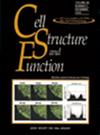BCR-ABL对应激颗粒的定位有助于其致癌功能。
IF 2.2
4区 生物学
Q4 CELL BIOLOGY
引用次数: 0
摘要
致癌性酪氨酸激酶BCR-ABL激活多种信号通路,在慢性髓性白血病(CML)的发病机制中起致病作用;然而,这种嵌合蛋白的亚细胞分布仍然存在争议。在这里,我们报道BCR-ABL定位于应激颗粒,其颗粒定位有助于BCR-ABL依赖性白血病的发生。bcr - abl阳性颗粒不与任何膜结合细胞器标记物共定位,但与RNA颗粒成分HSP90a共定位。这些颗粒的数量随着thapsigargin的处理而增加,证实了这些颗粒是应激颗粒。鉴于用ABL激酶抑制剂伊马替尼治疗和消除BCR-ABL的n端区域可消除颗粒形成,因此颗粒形成需要激酶活性和卷曲-卷曲结构域。野生型BCR-ABL修复了il -3缺失的Ba/F3细胞的生长缺陷,而缺乏n端区域的突变型BCR-ABL则无法修复。此外,n端缺失突变体的强制四聚化不能恢复生长缺陷,这表明通过其n端形成颗粒,而不是四聚化,对bcr - abl依赖性的致癌性至关重要。我们的研究结果共同为BCR-ABL的CML发病机制提供了新的见解,并为开发新的治疗策略打开了一扇窗。关键词:BCR-ABL,亚细胞定位,应力颗粒。本文章由计算机程序翻译,如有差异,请以英文原文为准。
Localization of BCR-ABL to Stress Granules Contributes to Its Oncogenic Function.
The oncogenic tyrosine kinase BCR-ABL activates a variety of signaling pathways and plays a causative role in the pathogenesis of chronic myelogenous leukemia (CML); however, the subcellular distribution of this chimeric protein remains controversial. Here, we report that BCR-ABL is localized to stress granules and that its granular localization contributes to BCR-ABL-dependent leukemogenesis. BCR-ABL-positive granules were not colocalized with any markers for membrane-bound organelles but were colocalized with HSP90a, a component of RNA granules. The number of such granules increased with thapsigargin treatment, confirming that the granules were stress granules. Given that treatment with the ABL kinase inhibitor imatinib and elimination of the N-terminal region of BCR-ABL abolished granule formation, kinase activity and the coiled-coil domain are required for granule formation. Whereas wild-type BCR-ABL rescued the growth defect in IL-3-depleted Ba/F3 cells, mutant BCR-ABL lacking the N-terminal region failed to do so. Moreover, forced tetramerization of the N-terminus-deleted mutant could not restore the growth defect, indicating that granule formation, but not tetramerization, through its N-terminus is critical for BCR-ABL-dependent oncogenicity. Our findings together provide new insights into the pathogenesis of CML by BCR-ABL and open a window for developing novel therapeutic strategies for this disease.Key words: BCR-ABL, subcellular localization, stress granule.
求助全文
通过发布文献求助,成功后即可免费获取论文全文。
去求助
来源期刊

Cell structure and function
生物-细胞生物学
CiteScore
2.50
自引率
0.00%
发文量
6
审稿时长
>12 weeks
期刊介绍:
Cell Structure and Function is a fully peer-reviewed, fully Open Access journal. As the official English-language journal of the Japan Society for Cell Biology, it is published continuously online and biannually in print.
Cell Structure and Function publishes important, original contributions in all areas of molecular and cell biology. The journal welcomes the submission of manuscripts on research areas such as the cell nucleus, chromosomes, and gene expression; the cytoskeleton and cell motility; cell adhesion and the extracellular matrix; cell growth, differentiation and death; signal transduction; the protein life cycle; membrane traffic; and organelles.
 求助内容:
求助内容: 应助结果提醒方式:
应助结果提醒方式:


